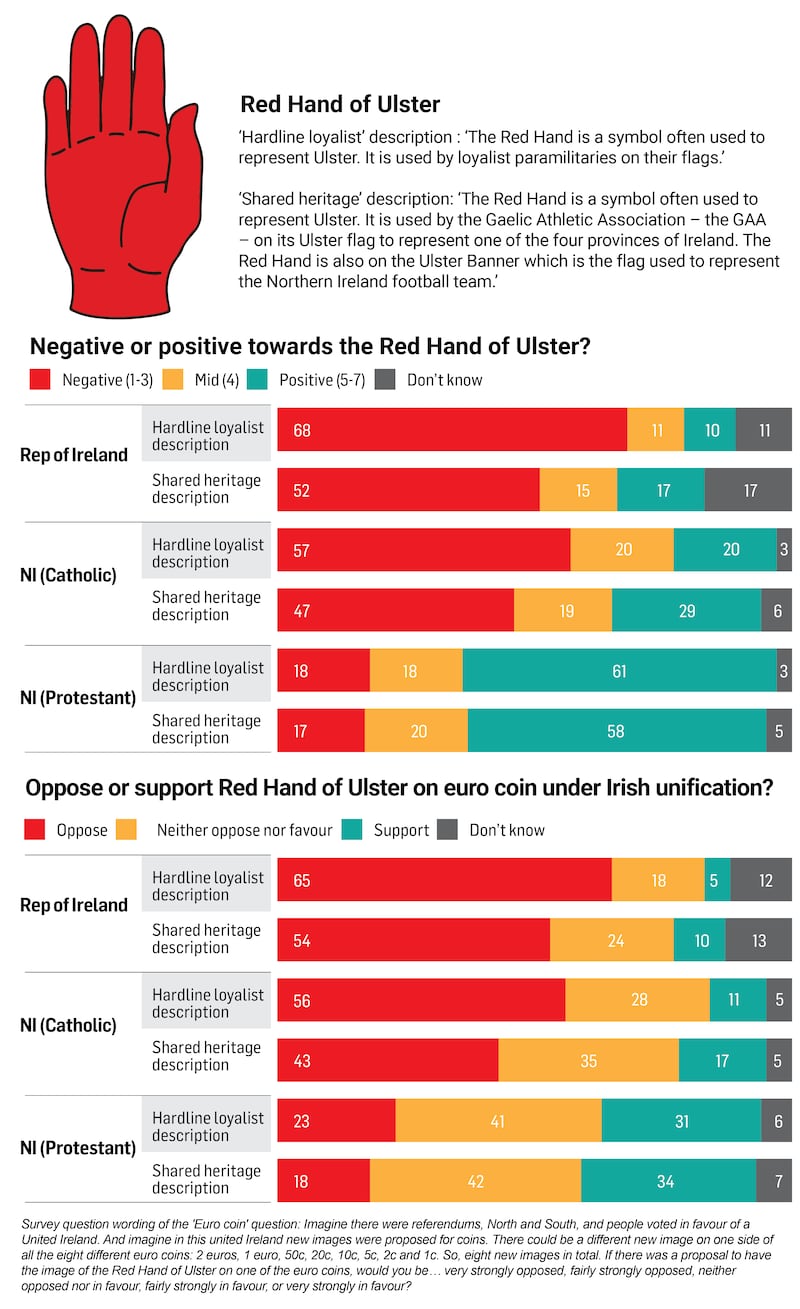Voters in the Republic are strongly hostile to symbols of Northern Ireland, according to the latest research on attitudes to symbols and flags as part of the Irish Times/ARINS North and South series.
They are negative towards the suggestion that the Red Hand of Ulster, or the poppy – traditionally used to commemorate the UK’s war dead – be included on the coinage of any new united Ireland.
But the strength of Southern voters’ opposition may vary depending on how the question was framed for them, the poll results suggest.
The latest batch of research for the Irish Times/ARINS North and South series seeks to examine attitudes among voters in Northern Ireland and the Republic to flags, emblems and symbols – and to the Commonwealth, the results of which were reported last week.
READ MORE
It also seeks to probe how those attitudes might be open to change by presenting the issues to respondents in two different ways.
[ Flags and symbols will remain a point of division between North and South ]
In today’s final instalment of the series, respondents in both jurisdictions were each split into two groups and were asked about their attitudes to the Red Hand of Ulster, the traditional symbol of Northern Ireland and the province of Ulster, in two different ways – one that linked the Red Hand symbol to its use by loyalist paramilitaries, and the other that noted its use by the GAA and the Northern Ireland soccer team.
They were also asked about the poppy in two ways – one that linked it to the commemoration of British war dead, and one that suggested it was “a symbol of remembering those who have died in war and conflict and is a symbol of a hopeful and peaceful future”.

But Southern feelings about the poppy do not appear to be affected by how it is presented: voters remain strongly negative towards it no matter how it is introduced.
Asked how they felt about the Red Hand of Ulster, Southern voters were overwhelmingly negative. Feelings of negativity were highest among voters who were told the Red Hand symbol was used by loyalist paramilitaries, with 68 per cent of southern voters describing negative feelings towards it, including 46 per cent who said they were “very negative”. Just 10 per cent said they were positive towards it.
Among voters who were told that the symbol was used by the GAA and the Northern Ireland soccer team, negativity was less intense, with 52 per cent of voters registering negative feelings, of whom 34 per cent were “very negative”. But this still greatly outnumbers those who registered positive feelings, who were at just 17 per cent of voters. A third (33 per cent) of voters either had neither negative nor positive feelings, or said they didn’t know.
There were strong majorities among both groups of voters against including the Red Hand on euro coins in a new united Ireland.
In the North, feelings about the poppy are strongly positive, no matter how it is described. Among Northern Ireland voters as a whole, emphasising the identification of the poppy with British war dead results in higher positive numbers. Unsurprisingly, voters are much more enthusiastic about putting the poppy on the coinage of a new united Ireland.
The Red Hand symbol is also, as expected, heavily influenced by whether respondents come from a Catholic or Protestant background. Overall, the North is on balance positive about the Red Hand symbol if its GAA and sporting usage are emphasised. However, among the group to which its use by loyalist paramilitaries is emphasised, the results were more mixed; negatives were 36 per cent, and positives were 39 per cent. A fifth of voters (20 per cent) were neither negative nor positive, and don’t knows were at 4 per cent.
The opinion polls are part of the North and South series, a research collaboration between ARINS and The Irish Times. ARINS, Analysing and Researching Ireland North and South, is a joint project of the Royal Irish Academy and the Keough-Naughton Institute for Irish Studies at the University of Notre Dame. This is the second year of the collaboration between The Irish Times and ARINS.
Two simultaneous, identical polls were taken by Ipsos B&A in the Republic and Ipsos in Northern Ireland, which conducted in-home interviews with over 1,000 voters in each jurisdiction. The margin of error in each is estimated to be +/-3.1 per cent.















